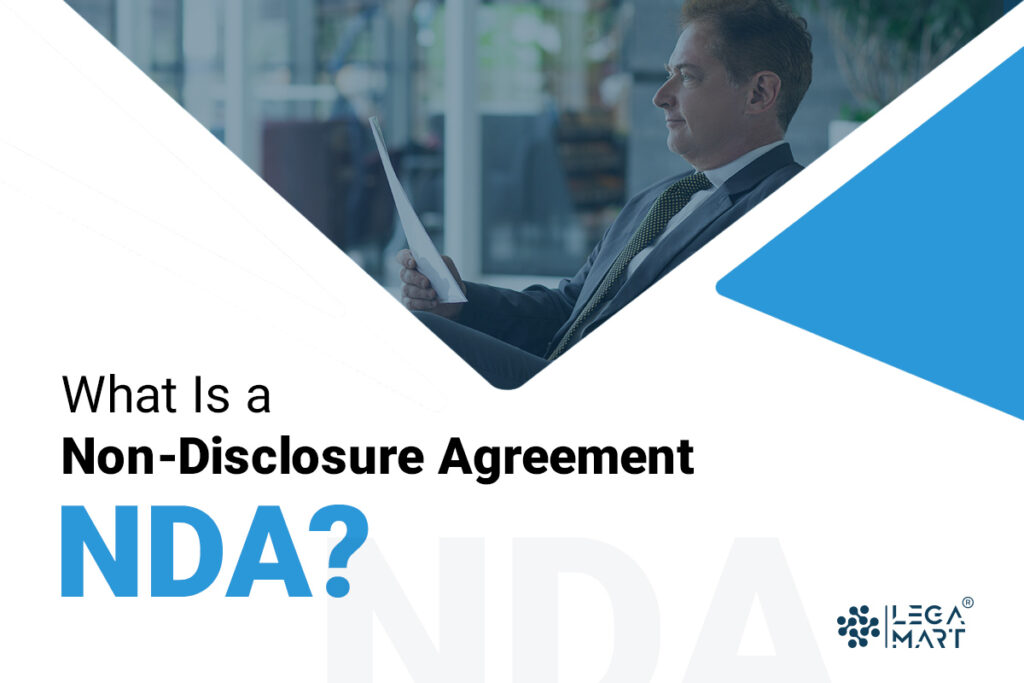- Introduction
- When do you need a non-disclosure agreement?
- Types of Non-Disclosure Agreements
- Requirements for an NDA
- Definition of Confidential Information
- Information Protected With NDA
- Exclusions to NDAs
- Precautions while creating and signing a Non-disclosure Agreement
- When is a non-disclosure agreement enforceable and when is it not?
- How to enforce an NDA?
- Advantages and Disadvantages of Having an NDA
- What Happens If You Break a Non-Disclosure Agreement?
- Frequently Asked Questions (FAQs)
Introduction
A Non-Disclosure Agreement is a legal contract between two or more parties in which parties involved agree not to disclose certain confidential information to third parties. NDAs protect trade secrets, proprietary information, and other sensitive data from being revealed to competitors or the general public. NDAs can be unilateral, bilateral, or multilateral, depending on the number of parties involved and the terms of the agreement. They may be used in employment, business transactions, and business partnerships.
By establishing this legal framework within the realm of Legal Practice & Specialization, an NDA acts as a shield, preventing the theft or unauthorized sharing of the business’s concepts and data, thus preserving your business’s competitive edge. It is important to remember that violating an NDA carries significant legal consequences, including potential lawsuits, financial penalties, and even the prospect of criminal charges. The comprehensive protection NDAs provide ensures that your business remains secure, even in unintentional breaches, allowing you to operate confidently in a world of sensitive information.
Why are NDAs Crucial for Small Businesses?
By safeguarding their confidential information, small businesses can maintain a competitive advantage, establish trust with partners and customers, and attract the necessary investments for their growth and expansion. Confidential information, including trade secrets, business plans, customer lists and financial data, provides a significant competitive advantage to small businesses. Here’s why NDAs are essential for small businesses:
- Protecting Customer and Client Information: NDAs can be employed to protect customer and client data, ensuring that their personal information remains confidential and is not disclosed to unauthorized parties. This builds trust with customers and clients.
- Safeguarding Confidential Information: NDAs are vital for protecting confidential information from falling into the wrong hands. This ensures a business can maintain a competitive edge by keeping its valuable data private.
- Building Trust: Signing an NDA signifies a commitment to confidentiality and fosters trust between the parties involved. This trust is especially critical in business partnerships, joint ventures, and situations where sensitive information may be shared.
- Preventing Intellectual Property Theft: NDAs play a crucial role in preventing intellectual property theft by making it unlawful for individuals to use or disclose a company’s confidential information without authorization.
- Attracting Investors: Investors are more inclined to invest in companies that have taken measures to safeguard their confidential information through NDAs. This can help businesses secure the capital they need for growth and expansion.
When Do You Need a Non-Disclosure Agreement?
You might be required to sign an NDA on multiple instances. Some of these instances are:
- While entering into a business deal: In case a vendor or a consultant is being invited, and you want to ensure that your information that is shared with such vendor or consultant remains safe, then signing an NDA is the best option. Especially for early-stage startups or startups with a relatively uncertain future, we recommend that all such startup employees sign an NDA. This move shall ensure that your company’s strategies, projected numbers, and funds are adequately protected.
- While starting a new project: NDA can also be helpful for established businesses that wish to start a new project in their business. Such a move usually requires the involvement of both internal and external stakeholders. Hence, signing an NDA helps avoid ambiguities or claims that can arise from either side during the term of the agreement.
- While talking to investors during mergers and acquisitions: While this has been a common practice in the past, however, today’s investors prefer not to sign an NDA at a very early stage. Preferably, when there is a need to look into the numbers and data of the company, the company can request the potential investors to sign an NDA. You can include the justifications for signing the NDA within the terms, making the mergers and acquisitions smooth.
- When collaborating with another Business: Businesses often collaborate and share sensitive information during negotiations. However, if the collaboration fails, the other party could potentially use this information against your business. It is wise for both parties to sign NDAs before starting negotiations, ensuring that the NDA restricts the use and sharing of confidential information.
- When hiring a consultant: Businesses frequently hire consultants to perform specific tasks, advise, or address various issues. Consultants may be exposed to sensitive information throughout their work. Having an NDA in place can help protect your information. Consultants may also have connections with your competitors, so it’s important to ask them about their affiliations and whether they represent any competitors.
- When bringing in Partners: Having a new partner or investor can be good for a small business. However, they might need to share sensitive details, such as trade secrets, financial info, and competitive strategies during negotiations. An NDA ensures this confidential info stays safe and allows the business to respond if it’s accidentally shared. Besides, businesses seeking funding may use an NDA to keep potential investors from sharing their trade secrets and business plans with rivals.
- When hiring an employee: When you hire employees, they gain access to sensitive aspects of your business, including trade secrets. To prevent them from sharing this information with third parties or using it for their purposes, many employers ask new employees to sign NDAs as part of their employment agreement. This is particularly important for high-level employees accessing the most sensitive company information. However, it’s crucial to strike a balance because low-level employees may find these agreements overly restrictive, and legal authorities may share that view.
Types of Non-Disclosure Agreements
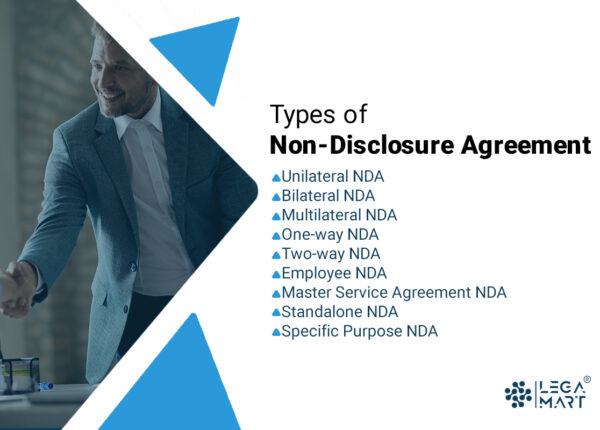
There are several types of Non-Disclosure Agreements, including:
Unilateral NDA: This type of NDA involves one party (the disclosing party) sharing confidential information with another party (the receiving party) who agrees not to disclose the information to third parties.
Bilateral NDA: This type of NDA involves two parties with information that they wish to share.
Multilateral NDA: This type of NDA involves multiple parties with information that they wish to share.
One-way NDA: A one-way NDA, also known as a one-sided NDA, is a non-disclosure agreement in which one party (the disclosing party) shares confidential information with another party (the receiving party) and the receiving party agrees not to disclose the information to third parties.
Two-way NDA: A two-way NDA, also known as a mutual NDA, is a non-disclosure agreement in which both parties share confidential information and agree not to disclose the information to third parties.
Employee NDA: This type of NDA is used when a company hires an employee, and they are required to sign an NDA to protect the company’s confidential information.
Master Service Agreement NDA: This type of NDA is used in professional service agreements between two companies, where both parties agree to keep certain information confidential.
Standalone NDA: A standalone NDA is a standalone legal agreement between two parties that agree to keep certain information confidential.
Specific Purpose NDA: This type of NDA is specific to a particular project or purpose, usually for a limited time.
Requirements for an NDA
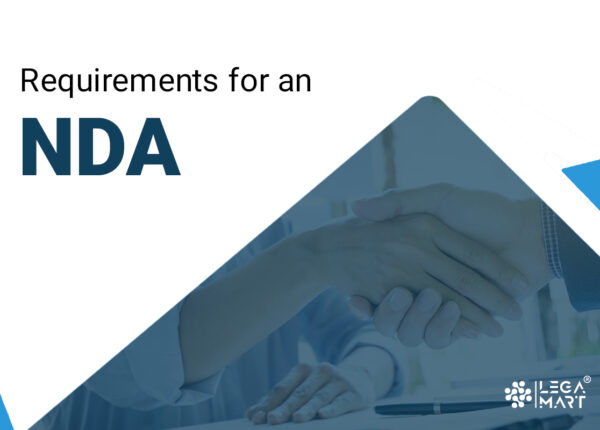
For a Non-Disclosure Agreement to be legally binding, it typically needs to include the following elements:
1) Identify the parties involved: The NDA should identify the parties involved, including the disclosing and receiving parties.
2)Define the confidential information: The NDA should clearly define the confidential information that is being protected, including the type of information, how it is being used and the scope of the protection.
3)Establish an obligation of confidentiality: The NDA should establish an obligation of confidentiality on the part of the receiving party, requiring them to keep the confidential information secret and not disclose it to any third parties.
4)Establish a period for confidentiality: The NDA should establish a specific period during which the receiving party must keep the confidential information secret.
5)Include an exclusions clause: The NDA should include an exclusions clause, which specifies any information that is excluded from the definition of confidential information, such as already publicly available information.
6)Include a termination clause: The NDA should include a termination clause, which establishes the conditions under which the NDA can be terminated.
7) Include a governing law clause: The NDA should include a governing law clause, which establishes the jurisdiction that will govern the NDA in case of any disputes.
8)Include a Signature: The NDA should be signed by both parties, and their authorized representatives, to make it legally binding.
What is a Confidential Information?
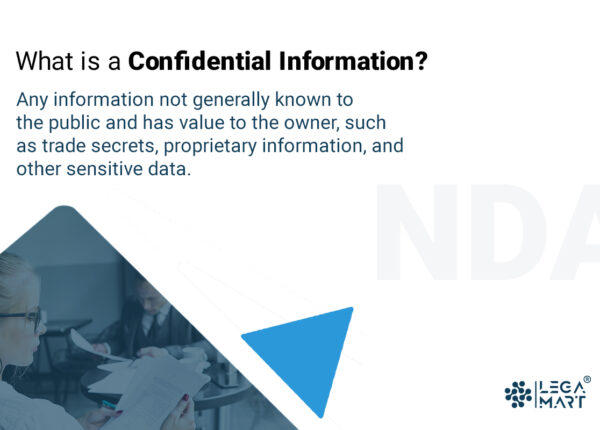
This is any information not generally known to the public and has value to the owner, such as trade secrets, proprietary information, and other sensitive data. In a non-disclosure agreement, the definition of confidential information is typically included in the agreement and defines the scope of the information that is being protected.
The definition of confidential information can include various types of information, such as:
1)Business plans, financial statements, and market research data
2)Research and development results
3)Customer lists and contact information
4)Product designs, specifications and production processes
5)Software code and other computer programs
6)Marketing and advertising strategies
Intellectual property, such as patents, trademarks, and copyrights It is important to ensure that the definition of confidential information is clear and specific to limit any ambiguity or confusion about what information is covered under the NDA.
Information Protected With NDA
A Non-Disclosure Agreement is typically used to protect confidential information, which is any information that is not generally known to the public and has value to the owner. The types of information that may be protected under an NDA can vary depending on the specific terms of the agreement and the nature of the relationship between the parties involved. Some common types of information that may be protected under an NDA include the following:
Trade secrets: This can include confidential business plans, financial statements, market research data, and other proprietary information that gives a company a competitive advantage.
Research and development results: This can include information about new products, services, or technologies that a company is developing, as well as data collected from experiments and testing.
Customer lists and contact information: This can include information about a company’s customers, such as names, addresses, and contact information, as well as their purchasing habits and preferences.
Product designs, specifications and production processes: This can include information about a company’s products, such as design drawings, engineering specifications, and how the products are manufactured.
Software code and other computer programs: This can include information about a company’s software programs and applications, such as source code and proprietary algorithms.
Marketing and advertising strategies: This can include information about a company’s marketing and advertising plans, such as the target audience, budget, and promotional activities.
Intellectual property: This can include information about a company’s patents, trademarks, and copyrights, as well as trade secrets related to intellectual property.
It’s important to note that while NDAs can protect confidential information, they cannot protect information that is illegal or in violation of other laws.
Exclusions to NDAs
A Non-Disclosure Agreement (NDA) typically includes an exclusions clause, which specifies any information excluded from the definition of confidential information. The exclusions to NDAs can vary depending on the specific terms of the agreement. Some common exclusions include:
Publicly available information: Information already in the public domain, such as information published in a newspaper or on the internet, is typically excluded from the definition of confidential information.
Information that is independently developed: Information that the receiving party develops independently, without using the disclosing party’s confidential information.
Information that is already known: Information that the receiving party already knows or possesses, such as information obtained from another source, is typically excluded from the definition of confidential information.
Information that is required to be disclosed by law: Information that is required to be disclosed by law, such as information that is required to be disclosed in a legal proceeding or to a government agency, is typically excluded from the definition of confidential information.
Information that is authorized to be disclosed: Information authorized to be disclosed by the disclosing party, such as information that is disclosed to a third party with the disclosing party’s permission, is typically excluded from the definition of confidential information. It’s important to note that some NDAs may also have special provisions such as a “reverse engineering” clause, which allows the receiving party to reverse engineer the confidential information to develop a similar product or service, but this should be clearly stated in the NDA.
Precautions While Creating and Signing a Non-Disclosure Agreement
Before signing an NDA with any company, prefer taking note of the following few points:
- Ensure that the information provided and the language of the contract is precise and unambiguous.
- Make sure that all involved parties have thoroughly read the NDA and, if required, verbally explain to them as well. This shall help avoid any potential misunderstandings between the parties.
- Avoid the inclusion of non-required clauses or conflicting sentences during the drafting of the agreement.
- Prefer having an expiration date for the agreement. Always keep the option of renewal open within the agreement.
When is a Non-Disclosure Agreement Enforceable and When is it Not?
While the exact rules related to non-disclosure agreements vary depending upon the jurisdiction, however, usually, non-disclosure agreements can be enforced so long as they are drafted and executed properly. For instance, it is preferred for the agreement to be supported by consideration, which acts as a legal way of explaining the “bargain of exchange” between the parties, acting similar to a situation where something is bargained for and received by a promisor from the promisee.
When it comes to employment-related NDA, when the employer gets the necessary protection of their confidential information, the employee is said to get at-will employment, which is capable of acting as a sufficient consideration for making non-disclosure agreements enforceable.
When it comes to unenforceability, there are various situations which are capable of rendering a non-disclosure agreement unenforceable:
- When the agreement language is too broad. If the language of the non-disclosure agreement is overly broad or too restrictive, it is likely for the courts to not accept such an agreement, especially in situations where it is not limited in scope and/or duration.
- When the information is not confidential, it can be difficult for a company to convince the court about the importance of a non-disclosure agreement if the information protected is not confidential and is rather open-source information.
- When the agreement expects the employee to do something illegal. If the non-disclosure agreement asks the employee to remain silent about something within the employee’s legal duty to report, such an agreement would be unenforceable in a court of law.
The unenforceability of non-disclosure agreements is not limited to such instances, and it is possible to create an endless list of circumstances that hold non-disclosure agreements enforceable. Therefore, clarify what kinds of non-disclosure agreements have been held unenforceable within your jurisdiction.
How to Enforce an NDA?
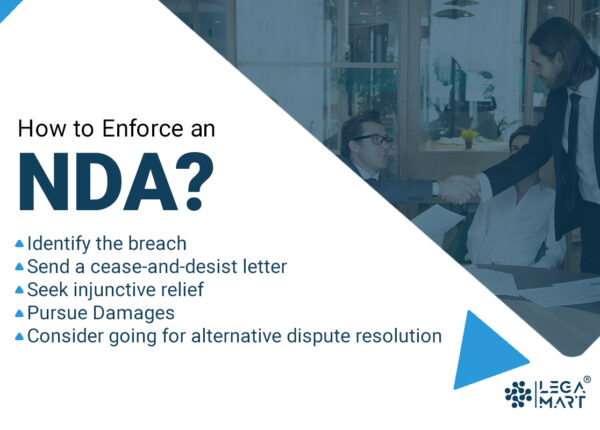
The following steps are taken by the companies to enforce an NDA to protect their confidential information. A few general steps are:
- Identify the breach. The first step is to identify the breach through the involvement of employees, review documents and communications, and conduct investigations.
- Send a cease-and-desist letter. Once you have identified the breach, the next step is to send the cease-and-desist letter to the party who breached the NDA. This acts as a legal notice, wherein you first outline the breach, demand the party to cease all further breaches, and provide a deadline for compliance with the letter.
- Seek injunctive relief. If the breaching party continues the breach, despite the cease-and-desist letter, the next step is to seek injunctive relief from the court. This involves filing a lawsuit and requesting a temporary restraining order or a preliminary injunction to prevent further breaches.
- Pursue Damages. If you have suffered any damages due to the breach, such as loss of profits or damage to reputation, you can also seek monetary damages through the lawsuit.
- Consider going for alternative dispute resolution. In a few cases, it is more efficient and cost-effective to go forward with alternative dispute resolution (like arbitration and mediation), rather than litigation to save time and costs.
Advantages and Disadvantages of Having an NDA
Non-Disclosure Agreements can provide several benefits but also have some potential drawbacks.
Advantages of NDAs
Protection of confidential information: NDAs can protect a company’s confidential information, such as trade secrets and proprietary information, from being revealed to competitors or the general public.
Facilitation of information sharing: NDAs can facilitate the sharing of confidential information between parties, such as in business transactions or partnerships, by providing a legal framework for protecting the information.
Legal recourse: NDAs provide legal recourse in case of a breach, allowing the disclosing party to take legal action against the receiving party if they disclose the confidential information without authorization.
Deterrence: NDAs act as a deterrent for potential breaches of confidentiality, as the receiving party is aware of the legal consequences if they disclose the information.
Disadvantages of NDAs
Limited disclosure: NDAs can limit the disclosure of information, which can impede the free flow of information and impede collaboration and innovation.
Legal costs: NDAs can be costly to draft and enforce, as legal fees may be incurred in case of a breach.
Limited enforceability: NDAs may not be enforceable in certain jurisdictions or situations, such as when the receiving party is required to disclose the information by law.
Time-consuming: NDAs can be time-consuming to draft and execute, and they can also be difficult to monitor and enforce.
Overly restrictive: NDAs can be overly restrictive, preventing the receiving party from using the information in ways that would be beneficial to them.
It’s worth noting that NDAs are unsuitable for all situations, and it’s important to consider the specific context and the parties involved before entering an NDA.
What Happens If You Break a Non-Disclosure Agreement?
If a party breaches a Non-Disclosure Agreement (NDA) by disclosing confidential information without authorization, the disclosing party may take legal action against the receiving party. The specific legal remedies available will depend on the jurisdiction where the NDA was executed and the terms of the agreement. Some common legal remedies for a breach of NDA include:
Injunctions: The disclosing party may seek an injunction, a court order requiring the receiving party to stop disclosing confidential information.
Monetary damages: The disclosing party may seek monetary damages, a sum of money awarded by the court as compensation for the harm caused by the breach of the NDA.
Specific performance: The disclosing party may seek specific performance, a court order requiring the receiving party to comply with the terms of the NDA.
Criminal sanctions: In some cases, a breach of NDA may be considered a criminal offence, and the breaching party may face criminal charges and penalties.
Loss of business: The disclosing party may suffer a loss of business due to the breach, and the receiving party may lose credibility and business opportunities.
It’s worth noting that, in some cases, a breach of NDA may also lead to additional legal action, such as a lawsuit for breach of contract or misappropriation of trade secrets. It is important to consult an attorney if you are considering taking legal action for a breach of NDA or facing legal action for a breach of NDA. LegaMart is always here to guide you further in your pursuit.
Additionally, it’s important to remember that a breach of NDA can also have reputational consequences for the breaching party, as it can damage their credibility and integrity in the industry, ultimately leading to a loss of business or other opportunities.
Frequently Asked Questions (FAQs)
Are non-disclosure agreements enforceable?
Non-disclosure agreements are legally binding contracts, and hence, they are legally enforceable as long as the breach can be proved.
What should be kept in mind while signing an NDA form?
During the course of employment or business, you would be asked to sign a non-disclosure agreement. Before signing, ensure that you have looked at the headings of ‘Confidentiality’, ‘Confidential Information’, or ‘Non-disclosure’. Further, pay attention to the time till the NDA shall remain in effect, especially since some NDAs can remain in effect past the term of employment. In addition, ensure that the information deemed confidential is not too overreaching or vague. Lastly, understand what is considered a contract breach under the NDA.
Conclusion
A nondisclosure agreement serves as a vital tool for preserving confidentiality and safeguarding the intellectual assets of your business. Whether shielding proprietary information, guarding trade secrets, or securing confidential data, an NDA establishes a robust legal framework to prevent unauthorized disclosure. By embracing NDAs, your business can confidently engage in partnerships, collaborations, and negotiations, knowing your sensitive information is well protected. These agreements provide both a shield and a deterrent, discouraging potential breaches through the fear of legal consequences, including litigation and financial penalties. In essence, NDAs are the guardians of your business’s secrets, ensuring that your innovative ideas and confidential information remain safe from prying eyes and unauthorized sharing.

